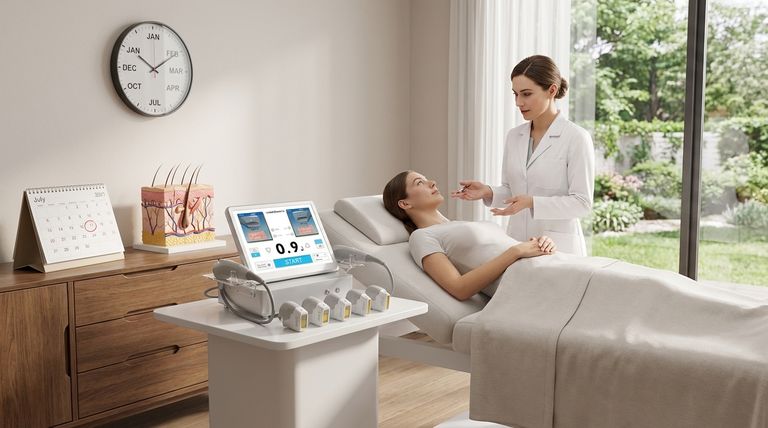Determining the optimal frequency for High-Intensity Focused Ultrasound (HIFU) treatments is crucial for achieving the best possible results. For an initial corrective course, the standard protocol is a series of treatments with each session spaced 12 weeks apart. After this initial phase, results are typically maintained with one or two sessions per year.
The effectiveness of HIFU is tied directly to your body's natural collagen production cycle. Spacing treatments properly allows this biological process to complete, ensuring each session builds upon the previous one for cumulative, long-lasting results.

The Rationale Behind the 12-Week Interval
Understanding why a three-month gap is recommended requires understanding how HIFU interacts with your skin at a deep, biological level. The waiting period isn't arbitrary; it's designed to align with your body's natural regenerative timeline.
Triggering the Body's Healing Response
HIFU delivers focused ultrasound energy deep into the skin, creating precise points of thermal injury. This controlled damage acts as a powerful signal to your body.
In response, your system initiates a sophisticated healing process to repair these points.
The Collagen Remodeling Cycle
This healing process is what stimulates the production of new, strong collagen and elastin—the proteins responsible for skin firmness and elasticity.
This process, known as neocollagenesis, unfolds over several months. While some initial tightening may be visible, the most significant results appear as this new collagen matures, typically peaking around the three-month mark.
Building on a Completed Foundation
Performing a second treatment after 12 weeks ensures you are building on the peak results of the first session.
This timing allows the full regenerative cycle to complete, creating a new, stronger foundation for the next treatment to improve upon.
Planning Your Long-Term Maintenance Strategy
Once you complete your initial course, the goal shifts from correction to maintenance. The focus becomes proactively counteracting the natural aging process.
The Goal of Maintenance
A maintenance session is designed to give your body's collagen production a strategic boost before it can significantly decline.
This keeps your skin's foundational structure strong and helps prolong the initial results for as long as possible.
The Annual or Bi-Annual Cadence
For most individuals, a maintenance treatment once or twice a year is sufficient to sustain the desired level of firmness and lift.
This frequency effectively compensates for the body's natural, age-related slowdown in collagen production without over-treating the skin.
The Critical Mistake: Why More Frequent Isn't Better
It can be tempting to think that more frequent treatments will lead to faster or better results, but this approach is counterproductive. Rushing the process works against the very biological mechanism that makes HIFU effective.
Interrupting the Biological Timeline
Treating the area again before the 12-week cycle is complete interrupts the collagen maturation phase. You are not giving the tissue the necessary time to fully heal and remodel.
The Risk of Diminishing Returns
Starting a new session too early means you aren't building on a fully realized result. This is inefficient and can lead to a less dramatic overall outcome for the cost and time invested.
Trusting the Process
HIFU's power lies in its ability to work with your body. Respecting its natural timeline is fundamental to the success of the treatment.
How to Determine Your Ideal Schedule
Your specific plan should always be confirmed with a qualified practitioner, but these principles provide a reliable guide.
- If you are starting your first HIFU course: Plan for sessions to be spaced approximately 12 weeks apart to achieve the best foundational result.
- If you are maintaining your results after an initial course: Schedule a follow-up treatment once or twice a year to sustain collagen production and prolong your outcome.
- If you are considering your options: Be skeptical of any protocol that advises treatments more frequently than every 12 weeks, as this does not align with the clinical understanding of the skin's regenerative cycle.
Properly timing your HIFU treatments ensures you are working in sync with your body's natural regenerative power for the best possible outcome.
Summary Table:
| Treatment Phase | Recommended Frequency | Key Rationale |
|---|---|---|
| Initial Corrective Course | Every 12 weeks | Allows full collagen remodeling cycle to complete, building a strong foundation. |
| Long-Term Maintenance | Once or twice per year | Proactively boosts collagen production to counteract natural aging. |
Ready to create a personalized HIFU treatment plan that maximizes your results?
At BELIS, we specialize in providing professional medical aesthetic equipment, including advanced HIFU systems, to medical aesthetics clinics and premium beauty salons. Our expertise ensures your clients achieve safe, effective, and long-lasting outcomes by following scientifically-backed protocols.
Contact our specialists today to learn how our equipment and support can enhance your service offerings and client satisfaction.
Visual Guide

Related Products
- 7D 12D 4D HIFU Machine Device
- 4D 12D HIFU Machine Device for Skin Tightening and Lifting
- 4D 12D HIFU Machine Device for Skin Tightening
- 12D HIFU Machine Device for Facial HIFU Treatment
- Hydrofacial Machine with Facial Skin Analyzer and Skin Tester
People Also Ask
- Is HIFU skin tightening safe? Ensure Your Safety with a Qualified Professional
- How frequently should you do HIFU? Optimize Your Results with the Right Schedule
- How long does it take for HIFU to start working? See Full Results in 2-3 Months
- What is the best frequency for HIFU treatment? Achieve Lasting Lifting & Tightening Results
- What are the benefits of HIFU machine? Achieve Non-Surgical Skin Lifting & Tightening



















